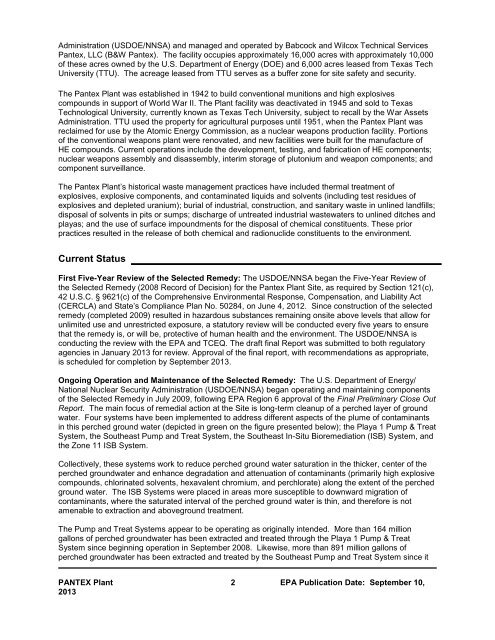PANTEX PLANT - US Environmental Protection Agency
PANTEX PLANT - US Environmental Protection Agency
PANTEX PLANT - US Environmental Protection Agency
Create successful ePaper yourself
Turn your PDF publications into a flip-book with our unique Google optimized e-Paper software.
Administration (<strong>US</strong>DOE/NNSA) and managed and operated by Babcock and Wilcox Technical Services<br />
Pantex, LLC (B&W Pantex). The facility occupies approximately 16,000 acres with approximately 10,000<br />
of these acres owned by the U.S. Department of Energy (DOE) and 6,000 acres leased from Texas Tech<br />
University (TTU). The acreage leased from TTU serves as a buffer zone for site safety and security.<br />
The Pantex Plant was established in 1942 to build conventional munitions and high explosives<br />
compounds in support of World War II. The Plant facility was deactivated in 1945 and sold to Texas<br />
Technological University, currently known as Texas Tech University, subject to recall by the War Assets<br />
Administration. TTU used the property for agricultural purposes until 1951, when the Pantex Plant was<br />
reclaimed for use by the Atomic Energy Commission, as a nuclear weapons production facility. Portions<br />
of the conventional weapons plant were renovated, and new facilities were built for the manufacture of<br />
HE compounds. Current operations include the development, testing, and fabrication of HE components;<br />
nuclear weapons assembly and disassembly, interim storage of plutonium and weapon components; and<br />
component surveillance.<br />
The Pantex Plant’s historical waste management practices have included thermal treatment of<br />
explosives, explosive components, and contaminated liquids and solvents (including test residues of<br />
explosives and depleted uranium); burial of industrial, construction, and sanitary waste in unlined landfills;<br />
disposal of solvents in pits or sumps; discharge of untreated industrial wastewaters to unlined ditches and<br />
playas; and the use of surface impoundments for the disposal of chemical constituents. These prior<br />
practices resulted in the release of both chemical and radionuclide constituents to the environment.<br />
Current Status<br />
First Five-Year Review of the Selected Remedy: The <strong>US</strong>DOE/NNSA began the Five-Year Review of<br />
the Selected Remedy (2008 Record of Decision) for the Pantex Plant Site, as required by Section 121(c),<br />
42 U.S.C. § 9621(c) of the Comprehensive <strong>Environmental</strong> Response, Compensation, and Liability Act<br />
(CERCLA) and State’s Compliance Plan No. 50284, on June 4, 2012. Since construction of the selected<br />
remedy (completed 2009) resulted in hazardous substances remaining onsite above levels that allow for<br />
unlimited use and unrestricted exposure, a statutory review will be conducted every five years to ensure<br />
that the remedy is, or will be, protective of human health and the environment. The <strong>US</strong>DOE/NNSA is<br />
conducting the review with the EPA and TCEQ. The draft final Report was submitted to both regulatory<br />
agencies in January 2013 for review. Approval of the final report, with recommendations as appropriate,<br />
is scheduled for completion by September 2013.<br />
Ongoing Operation and Maintenance of the Selected Remedy: The U.S. Department of Energy/<br />
National Nuclear Security Administration (<strong>US</strong>DOE/NNSA) began operating and maintaining components<br />
of the Selected Remedy in July 2009, following EPA Region 6 approval of the Final Preliminary Close Out<br />
Report. The main focus of remedial action at the Site is long-term cleanup of a perched layer of ground<br />
water. Four systems have been implemented to address different aspects of the plume of contaminants<br />
in this perched ground water (depicted in green on the figure presented below); the Playa 1 Pump & Treat<br />
System, the Southeast Pump and Treat System, the Southeast In-Situ Bioremediation (ISB) System, and<br />
the Zone 11 ISB System.<br />
Collectively, these systems work to reduce perched ground water saturation in the thicker, center of the<br />
perched groundwater and enhance degradation and attenuation of contaminants (primarily high explosive<br />
compounds, chlorinated solvents, hexavalent chromium, and perchlorate) along the extent of the perched<br />
ground water. The ISB Systems were placed in areas more susceptible to downward migration of<br />
contaminants, where the saturated interval of the perched ground water is thin, and therefore is not<br />
amenable to extraction and aboveground treatment.<br />
The Pump and Treat Systems appear to be operating as originally intended. More than 164 million<br />
gallons of perched groundwater has been extracted and treated through the Playa 1 Pump & Treat<br />
System since beginning operation in September 2008. Likewise, more than 891 million gallons of<br />
perched groundwater has been extracted and treated by the Southeast Pump and Treat System since it<br />
<strong>PANTEX</strong> Plant 2 EPA Publication Date: September 10,<br />
2013
















